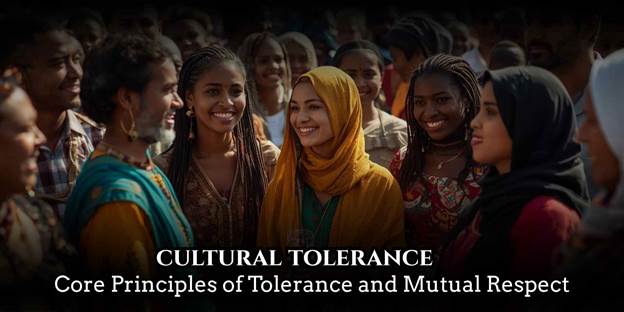Understanding Cultural Tolerance
Cultural tolerance refers to the ability to respect, accept, and appreciate the rich diversity of cultures that exist in human society. It encourages openness toward different traditions, beliefs, and lifestyles while fostering peaceful coexistence among communities. In today’s interconnected world, cultural tolerance has become one of the most essential traits for social harmony and global cooperation.
Table of Contents
This article explores the psychology, importance, challenges, and guiding principles behind cultural tolerance and mutual respect.

The Definition and Roots of Cultural Tolerance
Cultural tolerance stems from humanity’s shared desire for peaceful living. It means recognizing that cultural differences do not diminish human dignity or worth. Historically, the concept of tolerance dates back to early civilizations that relied on coexistence and trade, such as ancient Persia and Greece. Over time, thinkers like Voltaire and John Locke emphasized tolerance as the foundation of modern civil society.
In modern contexts, cultural tolerance extends beyond acceptance it involves understanding why others act or believe differently. It helps bridge the gaps caused by ethnic, linguistic, or religious distinctions and reduces prejudice in multicultural societies.
The Psychology Behind Tolerance and Respect
Psychologically, tolerance is linked to empathy and emotional intelligence. People with higher empathy levels can better appreciate others’ experiences and perspectives. Cultural tolerance develops when individuals overcome biases and stereotypes through awareness and education.
Key psychological elements of tolerance include:
- Empathy – the ability to step into another person’s cultural shoes.
- Cognitive flexibility – adapting one’s thinking to accept multiple viewpoints.
- Social learning – observing and modeling respectful behavior toward diversity.
When individuals practice these mental skills, they not only foster mutual respect but also build trust and cooperation across cultures.
Importance of Cultural Tolerance in Society
Cultural tolerance is not just a moral value it is a practical necessity. It strengthens communities and reduces social conflicts. In workplaces, schools, and governments, tolerance ensures fair participation for everyone, regardless of cultural background.
Benefits of cultural tolerance include:
• Promoting global peace and unity
• Reducing discrimination and social inequality
• Encouraging innovation through cultural exchange
• Building inclusive institutions and communities
For instance, multicultural countries like Canada and Singapore have shown that tolerance and mutual respect contribute directly to economic stability and civic harmony.
Core Principles of Tolerance and Mutual Respect
To achieve genuine cultural tolerance, societies must build upon a few fundamental principles that guide human interaction:
1. Equality of Dignity
Every person, regardless of race, religion, or background, deserves respect. This principle emphasizes that cultural differences should not lead to social hierarchy or exclusion.
2. Empathetic Understanding
Tolerance requires more than just passive acceptance it demands active effort to understand others’ viewpoints, stories, and struggles.
3. Freedom of Belief
Respecting cultural diversity includes protecting each individual’s right to think and believe freely, without fear of judgment or persecution.
4. Communication and Dialogue
Open dialogue helps dispel misunderstandings and fosters mutual respect. Encouraging conversations about cultural norms can bridge gaps between communities.
5. Shared Humanity
At its core, tolerance reminds us that despite cultural contrasts, all humans share common values love, kindness, and the desire for belonging.
Challenges in Practicing Cultural Tolerance
While promoting tolerance is ideal, achieving it is not without challenges. Prejudice, ethnocentrism, and misinformation often create barriers to understanding. Social media can amplify cultural stereotypes, leading to polarization rather than unity.
Common obstacles include:
• Misinterpretation of cultural behaviors
• Historical conflicts and inherited biases
• Lack of education about global diversity
• Fear of cultural change or loss of identity
Overcoming these issues requires continuous effort through education, cross-cultural exchange programs, and inclusive policymaking.

Real-World Examples of Cultural Tolerance in Action
Several initiatives around the world demonstrate the power of tolerance:
• The United Nations’ “World Tolerance Day” promotes respect for diversity globally.
• Interfaith dialogue programs in countries like Indonesia and Lebanon encourage cooperation among different religions.
• Educational campaigns that teach students about multiculturalism help reduce prejudice from an early age.
These examples highlight that cultural tolerance is not just theoretical it’s an active process that can be taught, practiced, and institutionalized.
The Role of Education in Promoting Tolerance
Education is the strongest tool for fostering cultural understanding. Schools that integrate multicultural curricula allow students to appreciate global perspectives. Learning about world history, languages, and traditions helps young people form positive attitudes toward others.
Teachers and educators can promote tolerance by:
• Encouraging cultural exchange projects
• Discussing global issues through diverse lenses
• Modeling respectful communication in classrooms
By nurturing inclusive values early on, societies can create generations that value diversity rather than fear it.
Conclusion
Cultural tolerance is the foundation of peaceful coexistence and global progress. By embracing diversity, practicing empathy, and upholding equality, societies can overcome cultural barriers and move toward unity. Promoting tolerance and mutual respect is not just about accepting differences it’s about celebrating them. Every act of understanding and compassion builds a more inclusive world, where cultural beliefs and traditions coexist harmoniously. Let’s all strive to learn, respect, and grow together in a culturally diverse planet.
1. What is cultural tolerance?
Cultural tolerance is the acceptance and respect for differences in traditions, beliefs, and lifestyles across societies.
2. Why is cultural tolerance important?
It fosters peace, social harmony, and inclusivity, allowing diverse groups to coexist without conflict.
3. What are the principles of tolerance?
The core principles include empathy, equality, freedom of belief, open dialogue, and shared humanity.